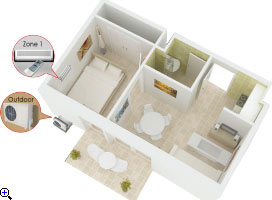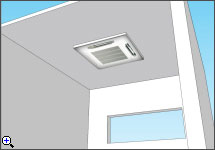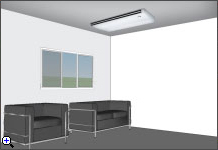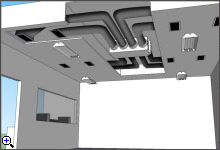What is a Ductless or Mini Split Air Conditioner?
Like central air conditioners, these units have a split design but without an elaborate system of ducts. The split system (also called a mini-split, ductless split, or duct-free system) has at least one unit inside the home (this is the evaporator) and one outdoor unit (the condenser). Small tubes of refrigerant run from the outdoor unit to the indoor units - these are also known as line sets. Indoor units can be wall or ceiling mounted. Ductless splits can be used to cool one zone or multiple zones applying two to four indoor units to one condenser - the indoor units can all be used independently of each other. (See details about ductless split warranties.)
How do I choose a ductless split air conditioner?
The most important factors when choosing a ductless split air conditioner are BTUs, number of cooling zones, and installation type. Zones A single zone ductless split system will have one evaporator, or air handler (indoor unit), and one condenser (outdoor unit). If you want to cool more than one area, a multiple zone split system applies two, three, or four (depending on the model) indoor units to one condenser. Normally its one unit per room - just make sure there is enough BTUs to cover the square footage in the room.
 |
 |
|
BTUs (British Thermal Units) BTUs are units of power - the larger the area you need to cool, the more BTUs you need. This is very straight forward for a single zone split system. For multiple zone systems, both the outdoor units and the indoor units will have a set number of BTUs. One of the benefits of a ductless split system is that each indoor unit runs independently. Therefore, the total number of BTUs for the indoor units can exceed the outdoor unit's BTU by up to 30%, but all the units cannot operate (on maximum) at once. Installation Type There are many different options of indoor units. One type of indoor unit is mounted on the wall. Select wall mounted units will come with customizable front panels that look like picture frames or pieces of art. Another type goes on the ceiling. Ceiling units can be suspended, recessed into the ceiling or concealed inside the ceiling. Ceiling units are for single zone applications only (multiple zone ceiling units are not available). Please keep in mind that ductless split systems have to be installed by a certified HVAC technician.
 |
 |
 |
 |
| Ceiling Recessed | Ceiling Suspended | Concealed Duct | Wall Mounted |
What are single zone and multiple zones?
Single zone means that there is only one indoor unit, and multiple zones means there are two to four indoor units for one condenser - each unit can be set to a different temperature and function independently. (Note that if the outdoor unit is equipped for more than one zone - you do not need to use all of the outlets). It is best to get an indoor unit for each room you are trying to cool - just make sure the BTUs are enough to cover the square foot area of all of the rooms.
 |
 |
|
What are the pros and cons of a ductless split air conditioner?
Ductless split air conditioners are a cost effective choice compared to central air conditioning. They are typically more expensive than wall or window air conditioners and you need an HVAC professional to install the unit. Since the compressor sits outside, ductless split air conditioners are very quiet and efficient. The indoor units do not need to vent through an exterior wall, so ductless splits are a good option to cool rooms with no windows and no exterior walls. A ductless split system also provides more temperature control because each indoor unit can be set independently from the other units.
How do I install a ductless split air conditioner, why do I need a HVAC Professional?
Installing a ductless split air conditioner is more complicated that a window unit but far less complicated than installing central air. An HVAC professional will need to run lines for the coolant, electricity, and drainage. You will also need a HVAC professional to charge it with the right amount of coolants.
How big will the hole be in the wall?
This slightly varies depending on the unit you buy but, it is generally 3" in diameter.
Will a ductless split system work in the winter?
If you are installing a ductless split air conditioner for all times of the year (ex: a computer/server room) you will need to purchase an air conditioner that has low ambient operation. The unit can set for cooling even when the outdoor temperature drops below 41°F (5°C).
Do I need to purchase tubing?
Yes, you do need to purchase tubing (also called line sets) to install your ductless split air conditioner. The tubing will connect the indoor and outdoor units. The size of the tubing depends on how far the inside unit is going to be from the outdoor unit. If you are installing the indoor unit on an interior wall, you will also have to purchase a condensate pump to drain the excess condensation to the outside.
Do some ductless split air conditioners have heat?
Some ductless split air conditioners come with heat. Most work with a heat pump, but some models have electric heat strips as back up. Learn more about the different heating types.
Please note that it is standard for ductless splits to come with a one-year parts warranty. AJ Madison stands behind the product we sell and are dedicated to help you answer any questions throughout the lifetime of your ductless split system. The labor warranty should be provided by the HVAC professional installing your ductless split system.